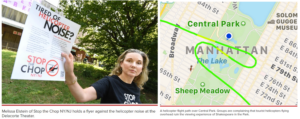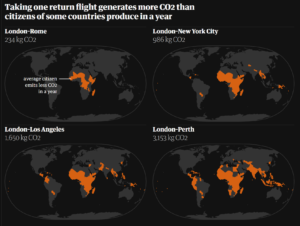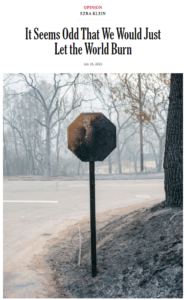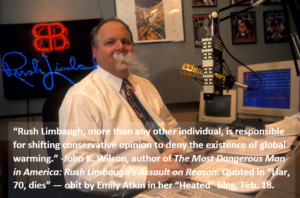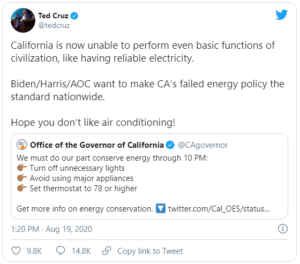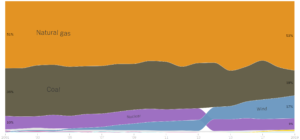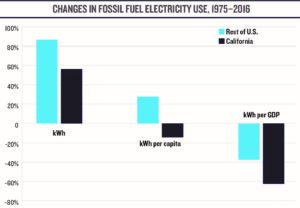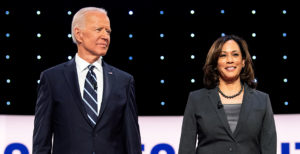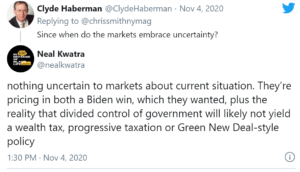This post, a teeth-clenched corrective to my late-April Diary of a Transit Miracle, was necessitated by Kathy Hochul’s jaw-dropping “indefinite pause” (read: cancellation) of the congestion pricing program she had supported since stepping into the governorship of New York State in August 2021. Like “Diary,” it first appeared in The Washington Spectator, which posted it on June 11 as Hochul Murder Mystery.
That title placed the spotlight on Hochul, whose decision it was to abandon New York City’s congestion pricing plan; on murder, because her delay jeopardizes the precariously perched program to charge drivers to the congested (and transit-rich) heart of the NY metro area a mere fraction of the added travel delays their trips impose; and on mystery, owing to the bizarreness of her abrupt turnabout.
Six days on, however, there’s a growing sense that Hochul simply panicked . . . that her belief in (and grasp of the rationale for) imposing a robust fee on private car trips to the Manhattan central business district was too slender to withstand the criticism from motorists for bringing congestion pricing to fruition.
What’s also growing, though, is the pushback to Hochul’s peremptory, unilateral decision. Not just “the usual suspects” — transit proponents, policy wonks and urbanists — but also business interests, infrastructure contractors and good-government advocates — are mounting a sustained counterattack intended to restore the congestion pricing timeline (it had been on track to “go live” on Sunday, June 30). While that outcome may be out of reach, the final chapter in New York’s congestion pricing saga has not necessarily been written.
Nevertheless, Hochul’s pullback underscores just how hard it remains to bring about meaningful externality pricing in the United States. The high hopes we at Carbon Tax Center had invested in NYC congestion pricing as a pacesetter require that we be candid: the setback to carbon pricing, should it stand, will be considerable.
— C.K., June 17, 2024
Note: Other than the photo montage, which we have reproduced from The Spectator, graphic elements here are new.

Photo montage: Riders Alliance
Not two months ago, in a brief history of how congestion pricing triumphed in New York, I canonized New York Governor Kathy Hochul, placing her alongside transportation legends Bill Vickrey (Nobel-winning traffic theorist), Ted Kheel (transit-finance savant), and the upstart Riders Alliance that in 2019 achieved what previous campaigners could not: legislation mandating a revolutionary new toll system that would weed out enough car trips to Manhattan’s core to cut down on endemic gridlock while generating revenue to enable generational expansions of subway and bus infrastructure.
Diary of a Transit Miracle, the Spectator titled that piece. Hochul, I wrote, had proved herself “a resolute and enthusiastic” congestion pricing backer. “Her spirited support,” I said, “became the decisive ingredient in shepherding congestion pricing to safety.”
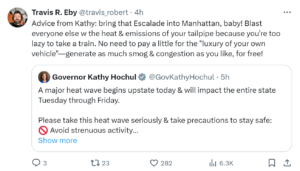
Twelve days after announcing her rescission of congestion pricing, Hochul is still being ferociously “dragged” on social media. Another tweet noted that “Hochul’s decision to blow a $15 billion hole in the MTA’s budget [means] she will get blamed for every single mass transit problem going forward in a city where the majority of people take public transit.”
The story, though infuriating to urbanists, climate advocates and foes of big-city car-dominance who for decades had looked to New York congestion pricing for deliverance, is also juicy. It’s hard to recall a public policy story with as many tentacles as this one.
Let us count the ways.
Hochul’s late-in-the-day reversal obviously is a New York story. With congestion pricing, the nation’s largest city, possessor of a singular global brand, was poised to recapture its pre-eminence in progressive, bold innovation. Instead, its literal engine ― its subway system ― has been jilted at the altar.
It’s also a dystopian governance story, as befits the unilateral monkey-wrenching of a policy forged by thousands of individuals, agencies and organizations over years and, for some, decades. As livable-streets journalist Aaron Naparstek wrote on Twitter, Hochul and her Congressional consiglieres “aren’t just undermining congestion pricing, they’re discrediting the Democratic Party and they’re undermining faith in government and democracy.” New York Times editorial writer Mara Gay lamented that “Americans didn’t need a reason to feel more cynical about politics. But Gov. Kathy Hochul of New York has delivered one.”
And of course, it’s a traffic and transit story. How will New York City solve or at least mitigate its habitual, maddening gridlock, which, notwithstanding post-pandemic office malaise, was revealed last week by city transportation officials to have grown even more strangulating than it was in 2019.
Answer: it won’t. Without congestion pricing’s stiff but fair $15 toll to drive into Manhattan south of 60th Street during most hours, alternative measures to reduce New York’s staggeringly costly traffic gridlock will invariably succumb to the dreaded “rebound effect.”
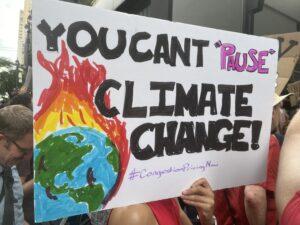
Sign at June 12 rally across from Hochul’s midtown office. An estimated 800 New Yorkers marched for congestion pricing, chanting “Safer streets, cleaner air, Governor Hochul doesn’t care.” Photo by author.
And how will Hochul and the Metropolitan Transportation Authority she commands come up with a billion-dollar-a-year revenue stream to cover the interest on $15 billion in long-awaited investments in subway station elevators, digital train signals, and clean, electric buses?
Answer: they likely won’t. In a chessboard win for congestion pricing proponents, legislative leaders last week refused to rubber-stamp Hochul’s wished-for hike in the Payroll Mobility Tax, leaving her with no means to fund the new transit improvements, and putting at risk thousands of jobs in upstate factories as well as downstate. With congestion pricing the only apparent way to pay for these investments, the resistance stays alive.
Did I say resistance? The widespread pushback to the governor constitutes yet another tentacle to the story. If Hochul thought that protests over her surprise cancellation would peter out, she was badly mistaken. What began as public astonishment quickly turned to upset and grew to outrage, not just for its transit and traffic consequences but for its sheer stupidity (per climate-conscience Bill McKibben) and cowardice and cravenness (per congestion pricing campaigner Alex Matthiessen).
Nor is the rage confined to transit wonks and bike advocates. It is being expressed by the transit construction and engineering companies; by business leaders and real estate interests; by the Daily News’ editorial board as well as the Times’; by the unquenchable Families for Safe Streets who since 2018 have put their bodies on the line to spare future bereaved mothers; by urbanists who hoped other cities would follow in New York’s footsteps; and by “supply side progressives” desperate for America to actually address urban and suburban gridlock as well as housing and climate.
The fury at the governor shows no signs of abating. Midway through writing this article I attended a Riders Alliance protest in East New York where Hochul was derided as Congestion Kathy and Governor Gridlock and her face photoshopped on a faux Daily News headline, “Hochul to City: Drop Dead. Gov. Betrays Millions of Riders.” Every hour, it seems, brings word of a new demonstration, another rally, another elected official and civic leader resolving to harass and if need be break Kathy Hochul to put congestion pricing back on track.
Hochul’s action is also a car culture story. Though the city’s car-besieged and transit-rich Manhattan core is perfectly suited for congestion pricing, New York remains part of the United States and thus under the sway of mercenary auto and oil interests. Many of the city’s long-immiserated straphangers, moreover, aspire to car ownership and bristle over tolls they might someday pay, even though few working-class residents of Brooklyn, Queens, Staten Island or the Bronx routinely motor to the congestion zone. Perhaps that is why the subway improvements that the tolls would pay for have yet to resonate with most “everyday” New Yorkers.
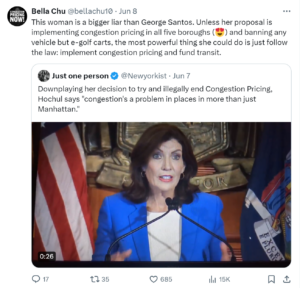
The distemper over the governor’s last-minute cancellation isn’t subsiding.
As well, New York’s political class is subway-avoidant and car-besotted, making them kissing cousins to suburban interests whose car windshields render them immune to transit’s value, except perhaps to keep others from clogging “their” road space. That the political ramifications eluded Gov. Hochul only adds spice to the story. That Manhattan and New York City as a whole couldn’t, last week, defy America’s “dominant car culture,” as the Times wrote in its Saturday editorial, is yet another sad aspect of the story.
We come now to the biggest and most puzzling piece of the Hochul congestion pricing saga: Why did she do it?
Why, after uttering nary a negative word about congestion pricing in her thousand days as governor, did she fold with a mere 25 days to go? Why, after extolling congestion pricing repeatedly and evincing genuine pleasure in being its tribune, did the governor move to murder it?
The standard explanation is that key national Democrats, most notably Brooklyn Congressmember and House Speaker-in-waiting Hakeem Jeffries, and perhaps senior White House officials as well, ordered Hochul to ice the June 30 launch to tamp voter defections in borderline House districts. This account is plausible if misguided, given that the four-month interval from June 30 to November 5 afforded ample time to “reset the default,” as Stockholm showed after its 2007 plunge into congestion pricing. The toll’s ostensible unpopularity would have ended up in the proverbial rearview mirror.
Yet these electoral concerns don’t fully add up. Any politician worth their salt knows not to abruptly reverse course on hot-button issues. And while altered circumstances can justify altered policies, no substantive change suddenly roiled New York’s transportation patterns, transit needs or economic vulnerabilities. Indeed, the governor’s fumbling attempts at justification have convinced no one.
Perhaps Hochul, an upstater and baby-boomer, was too ensnared in car culture to believe her own congestion pricing rhetoric. Perhaps campaign cash from automobile dealers moved her needle. Maybe she panicked and lost the words to tell Jeffries that helping him would destroy her political viability, end of conversation.
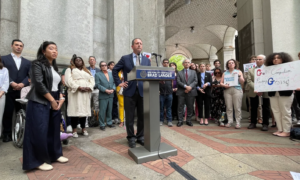
NYC Comptroller Brad Lander, a staunch supporter of congestion pricing, at a June 12 rally opposite City Hall, announcing litigation to invalidate Hochul’s tolling cancellation. Photo: Dave Colon, Streetsblog NYC.
Whatever caused Hochul to abandon congestion pricing, her blunder is of spectacular proportions, or so it appears to this city dweller. The prospective upset to drivers ― and not all drivers, insofar as some regarded the tolls as a means to speed their commutes ― seems almost quaint next to the actual rage of toll proponents and the derision from much of the public.
The governor can still right the ship. She could offer to lighten the toll burden around the edges, as I outlined last week. She could propose a June 30, 2025 referendum, an idea patterned on Stockholm, although who should be eligible to vote isn’t clear and could become its own bone of contention. She could cite the legislature’s hold on alternative transit funding and admit that Plan A was right all along.
The key word is admit. Not only is congestion pricing made for New York, its prolonged gestation has built it into expectations for transit finance, traffic management and the health of the city that cannot be easily unraveled.
Whatever precipitated Gov. Hochul’s loss of nerve, and whatever the consequences for her governorship and her remaining time in politics, she must reinstate congestion pricing. The need is too great, and the story too scandalous, to pretend that congestion pricing will go gentle into its good night.

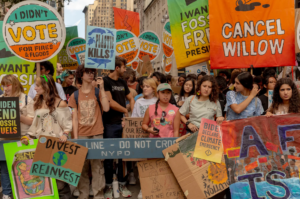
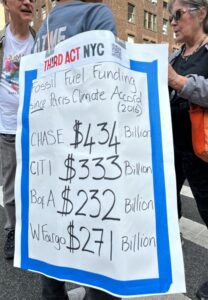
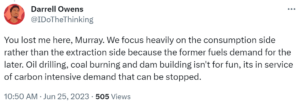


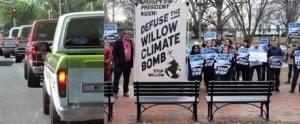
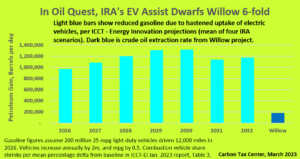
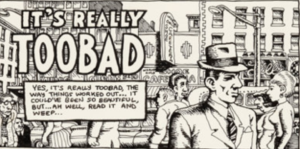

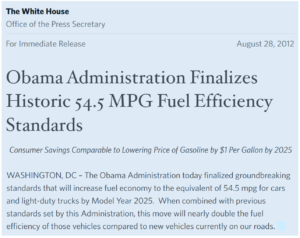
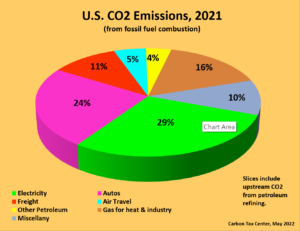
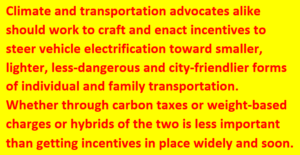 The supposed impossibility of reducing the use of gasoline by raising its price has been part and parcel of Big Green’s attachment to mpg standards — despite the fact that mileage reg’s do nothing to reduce driving and its vast negative consequences: not just traffic congestion but also poor health (sedentary living, car crashes, noise) and general unaffordability (car loan costs, upkeep expenses, costlier housing due to cars’ consuming urban and suburban land).
The supposed impossibility of reducing the use of gasoline by raising its price has been part and parcel of Big Green’s attachment to mpg standards — despite the fact that mileage reg’s do nothing to reduce driving and its vast negative consequences: not just traffic congestion but also poor health (sedentary living, car crashes, noise) and general unaffordability (car loan costs, upkeep expenses, costlier housing due to cars’ consuming urban and suburban land).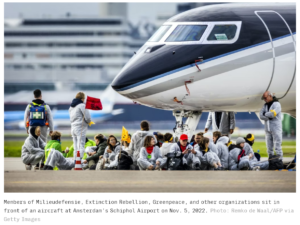 They had to move quickly before military police, tasked with securing the airport, saw what was happening. The rebels targeted 13 private jets parked or preparing for takeoff, at least two belonging to NetJets, the Berkshire Hathaway subsidiary that bills itself as the world’s largest jet company and sells fractional ownership shares in private business jets.
They had to move quickly before military police, tasked with securing the airport, saw what was happening. The rebels targeted 13 private jets parked or preparing for takeoff, at least two belonging to NetJets, the Berkshire Hathaway subsidiary that bills itself as the world’s largest jet company and sells fractional ownership shares in private business jets.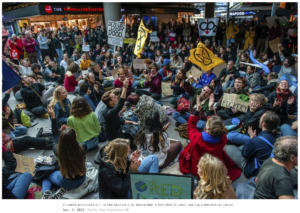 The justification is unarguable. Large personal fortunes feed carbon consumption and make a mockery of programs to curb it. As well, the surplus wealth of the superrich is probably the lone source of capital that can finance the worldwide uptake of greener energy and also pay for adaptation where it’s most critical.
The justification is unarguable. Large personal fortunes feed carbon consumption and make a mockery of programs to curb it. As well, the surplus wealth of the superrich is probably the lone source of capital that can finance the worldwide uptake of greener energy and also pay for adaptation where it’s most critical.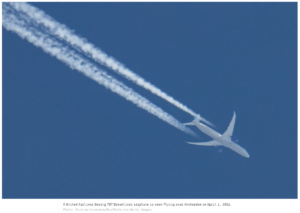 “What the Schiphol people needed to do is destroy the airplanes on the tarmac and then destroy the airplane manufacturers,” said an ecosaboteur named Stephen McRae, an acquaintance of one of the authors, who recently completed a six-year prison sentence for industrial sabotage. Although he no longer participates in such criminal acts of destruction, he has a point. The planes grounded on November 5 are already back in the air. That doesn’t diminish the value of what the Schiphol rebels did, however. Actions that disrupt carbon comfort without violence or hardship are morale-building, the material from which more actions and eventually mass movements are made.
“What the Schiphol people needed to do is destroy the airplanes on the tarmac and then destroy the airplane manufacturers,” said an ecosaboteur named Stephen McRae, an acquaintance of one of the authors, who recently completed a six-year prison sentence for industrial sabotage. Although he no longer participates in such criminal acts of destruction, he has a point. The planes grounded on November 5 are already back in the air. That doesn’t diminish the value of what the Schiphol rebels did, however. Actions that disrupt carbon comfort without violence or hardship are morale-building, the material from which more actions and eventually mass movements are made.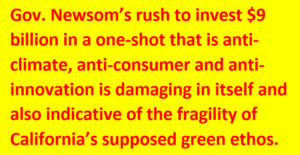 I know that record well. Not long ago, I did a study comparing California’s rate of decarbonizing its economy to the rest of the country’s. I found that from the mid-1970s to 2016, California drove down its use of fossil fuels per unit of economic activity nearly 20 percent faster than the other 49 states. Had those states matched California’s pace, I calculated, the country would now, each year, be eliminating 1,200 megatonnes of CO2, an amount equivalent to the carbon emissions from our entire fleet of passenger cars.
I know that record well. Not long ago, I did a study comparing California’s rate of decarbonizing its economy to the rest of the country’s. I found that from the mid-1970s to 2016, California drove down its use of fossil fuels per unit of economic activity nearly 20 percent faster than the other 49 states. Had those states matched California’s pace, I calculated, the country would now, each year, be eliminating 1,200 megatonnes of CO2, an amount equivalent to the carbon emissions from our entire fleet of passenger cars.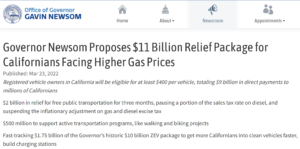
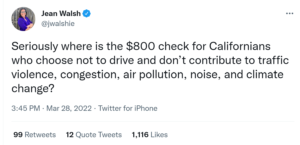


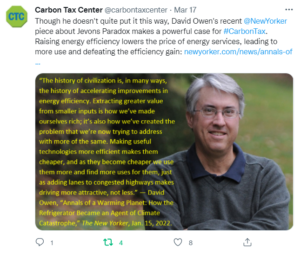 Owen’s article, which is well worth reading for its narrative power and climate relevance as well as its iconoclasm, was his latest exposition of Jevon’s Paradox, the phenomenon by which increases in energy efficiency lower the price of “energy services” and thus lead to more use, undercutting the efficiency gain. The antidote, of course, is to ensure the energy services — cooling, travel, lighting, and so forth — don’t plunge in price by raising the price of energy provision, as I pointed out a decade ago in a post in Grist,
Owen’s article, which is well worth reading for its narrative power and climate relevance as well as its iconoclasm, was his latest exposition of Jevon’s Paradox, the phenomenon by which increases in energy efficiency lower the price of “energy services” and thus lead to more use, undercutting the efficiency gain. The antidote, of course, is to ensure the energy services — cooling, travel, lighting, and so forth — don’t plunge in price by raising the price of energy provision, as I pointed out a decade ago in a post in Grist, 
